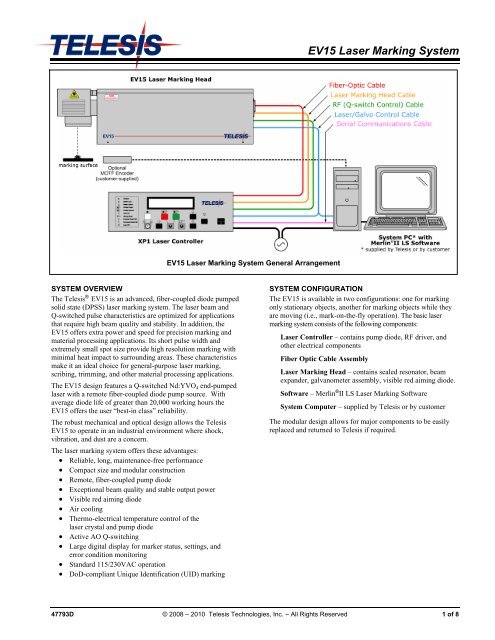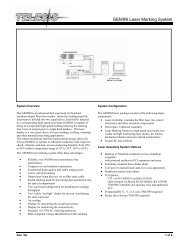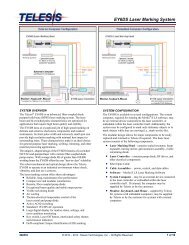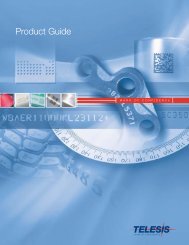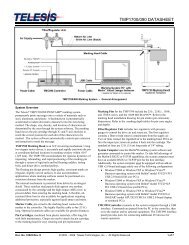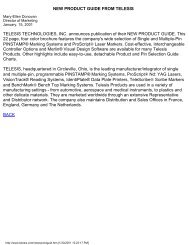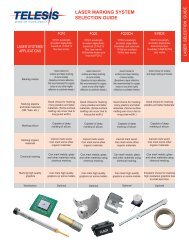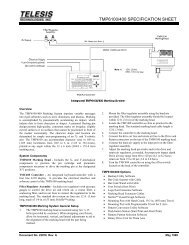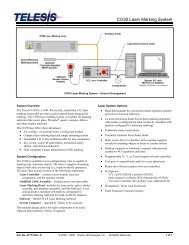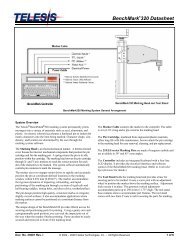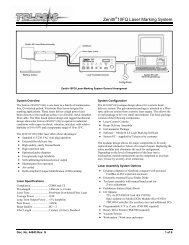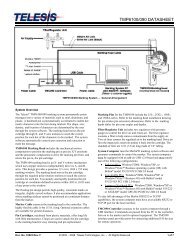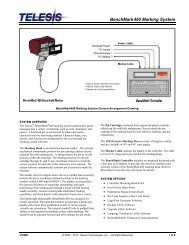EV15 Laser Marking System - Telesis Technologies, Inc.
EV15 Laser Marking System - Telesis Technologies, Inc.
EV15 Laser Marking System - Telesis Technologies, Inc.
You also want an ePaper? Increase the reach of your titles
YUMPU automatically turns print PDFs into web optimized ePapers that Google loves.
SYSTEM OVERVIEW<br />
The <strong>Telesis</strong> ® <strong>EV15</strong> is an advanced, fiber-coupled diode pumped<br />
solid state (DPSS) laser marking system. The laser beam and<br />
Q-switched pulse characteristics are optimized for applications<br />
that require high beam quality and stability. In addition, the<br />
<strong>EV15</strong> offers extra power and speed for precision marking and<br />
material processing applications. Its short pulse width and<br />
extremely small spot size provide high resolution marking with<br />
minimal heat impact to surrounding areas. These characteristics<br />
make it an ideal choice for general-purpose laser marking,<br />
scribing, trimming, and other material processing applications.<br />
The <strong>EV15</strong> design features a Q-switched Nd:YVO4 end-pumped<br />
laser with a remote fiber-coupled diode pump source. With<br />
average diode life of greater than 20,000 working hours the<br />
<strong>EV15</strong> offers the user “best-in class” reliability.<br />
The robust mechanical and optical design allows the <strong>Telesis</strong><br />
<strong>EV15</strong> to operate in an industrial environment where shock,<br />
vibration, and dust are a concern.<br />
The laser marking system offers these advantages:<br />
• Reliable, long, maintenance-free performance<br />
• Compact size and modular construction<br />
• Remote, fiber-coupled pump diode<br />
• Exceptional beam quality and stable output power<br />
• Visible red aiming diode<br />
• Air cooling<br />
• Thermo-electrical temperature control of the<br />
laser crystal and pump diode<br />
• Active AO Q-switching<br />
• Large digital display for marker status, settings, and<br />
error condition monitoring<br />
• Standard 115/230VAC operation<br />
• DoD-compliant Unique Identification (UID) marking<br />
<strong>EV15</strong> <strong>Laser</strong> <strong>Marking</strong> <strong>System</strong> General Arrangement<br />
<strong>EV15</strong> <strong>Laser</strong> <strong>Marking</strong> <strong>System</strong><br />
SYSTEM CONFIGURATION<br />
The <strong>EV15</strong> is available in two configurations: one for marking<br />
only stationary objects, another for marking objects while they<br />
are moving (i.e., mark-on-the-fly operation). The basic laser<br />
marking system consists of the following components:<br />
<strong>Laser</strong> Controller – contains pump diode, RF driver, and<br />
other electrical components<br />
Fiber Optic Cable Assembly<br />
<strong>Laser</strong> <strong>Marking</strong> Head – contains sealed resonator, beam<br />
expander, galvanometer assembly, visible red aiming diode.<br />
Software – Merlin ® II LS <strong>Laser</strong> <strong>Marking</strong> Software<br />
<strong>System</strong> Computer – supplied by <strong>Telesis</strong> or by customer<br />
The modular design allows for major components to be easily<br />
replaced and returned to <strong>Telesis</strong> if required.<br />
47793D © 2008 – 2010 <strong>Telesis</strong> <strong>Technologies</strong>, <strong>Inc</strong>. – All Rights Reserved 1 of 8
<strong>EV15</strong> <strong>Laser</strong> <strong>Marking</strong> <strong>System</strong><br />
SYSTEM SPECIFICATIONS<br />
Compliance ................................ CDRH<br />
<strong>Laser</strong> Type ................................. fiber-coupled, diode-pumped,<br />
Q-switched, Nd:YVO4<br />
Wavelength ................................ 1064 nanometers (nm)<br />
Mode........................................... TEM00<br />
Average Power .......................... 15 watts at 1064 nm<br />
Long Term Output Power Drift ... < ± 2%<br />
Max. Power Consumption......... < 500 watts<br />
Expected Diode Lifetime ........... > 20,000 hours<br />
Input Power ................................ 95 to 250 VAC, 6 amps,<br />
50/60 Hz single phase<br />
Supply Voltage Fluctuation ....... < ± 10% with clean ground line<br />
Operating Temperature............. 18° to 35°C (65° to 95°F)<br />
Recommended Temperature.... 20° to 25°C (68° to 77°F)<br />
Ambient Relative Humidity........ 10% to 85% non-condensing<br />
SYSTEM OPTIONS<br />
• Desktop computer or notebook computer with powered<br />
cardbus-to-PCI expansion enclosure<br />
• Remote pushbutton station (start/abort)<br />
• Externally-mounted focus-finder diode<br />
• Mark-on-the-fly kit to interface with customer-supplied<br />
encoder for marking objects in motion (linear or circular)<br />
• I/O options (see Remote Communications for details):<br />
TTL via PCI-DIO24 Board (Kit #53920)<br />
Opto-isolated via Merlin DCIO Module (Kit #53928)<br />
Two-axis Controller (for auxiliary axes; additional I/O)<br />
• Programmable tool post for vertical (z-axis) adjustment<br />
(requires two-axis controller)<br />
• Rotary drive fixture for rotational (theta-axis) adjustment<br />
(requires two-axis controller)<br />
• Workstation / work area enclosure<br />
• Fume extraction systems<br />
SYSTEM SETUP<br />
The following procedures are listed for reference only to provide a<br />
general overview of the installation process. Refer to the <strong>EV15</strong><br />
Installation & Maintenance Manual for complete installation details.<br />
Do not connect any power cable to power source<br />
until all system connections are made.<br />
1. Equipment should remain powered down and in OFF<br />
position until mounting is complete.<br />
2 of 8 47793D<br />
2. Place computer, monitor, keyboard, and laser controller<br />
in desired location. Locate controller as close as practical<br />
to laser marking head – typically within 1.5m (5.0 ft.);<br />
optionally within 4.75m (15.58 ft.) with longer cable set.<br />
� Ensure sufficient clearance on sides of laser<br />
controller (approx. 65 mm or 2.5 in.) to allow for<br />
air circulation.<br />
3. Place the laser marking head on selected mounting surface.<br />
� Do not bend or kink fiber optic cable. The fiber<br />
optic cable will tolerate approximately 300 mm<br />
(12 in.) diameter bend without damage.<br />
� Allow a minimum distance of 150 mm (6 in.) at rear<br />
of the laser marking head. This will provide sufficient<br />
room for a proper bend radius of fiber optic cable.<br />
� Do not block or obstruct exhaust vents or fans.<br />
Note location of the exhaust vents and fans on right<br />
side of the laser marking head (as viewed from the<br />
connector panel). These vents and fans must have<br />
adequate clearance to ensure proper cooling.<br />
� Ensure sufficient clearance on all sides of laser<br />
marking head (approx. 65 mm or 2.5 in.) to allow<br />
for air circulation.<br />
4. Mount laser marking head using three factory-tapped<br />
M5-0.8 mounting holes provided.<br />
a. Locate the three pre-drilled M5-0.8 mounting<br />
holes. Refer to the Dimensions & Mounting<br />
drawing for details.<br />
b. Mounting bolts must not extend into laser<br />
marking head more than 7.8 mm (.31 in.) to<br />
avoid interference with internal components.<br />
c. As viewed from the cable end of the laser marking<br />
head, the customer-supplied mounting fixture must<br />
not extend beyond the forward edge of laser<br />
marking head rail assembly to allow clearance for<br />
beam output lens.<br />
d. As viewed from the cable end of the laser marking<br />
head in upright position, the center of the output<br />
beam is 163.12 mm (6.422 in.) beyond the forward<br />
set of mounting holes and 95.17 mm (3.747 in.)<br />
inward from the left edge of the laser marking<br />
head.<br />
5. Secure the laser marking head to mounting fixture using<br />
three M5-0.80 bolts and lock washers. Torque to 47 in-lb<br />
(5.31 N-m). Do not over tighten bolts.<br />
6. Select proper fuse arrangement for the laser controller.<br />
Refer to the <strong>EV15</strong> Installation & Maintenance Manual.<br />
Connect power cable controller.<br />
7. Connect fiber optic cable and all remaining cables, as<br />
applicable.<br />
8. Refer to <strong>EV15</strong> Operation Supplement for proper startup<br />
procedure. Refer to the Merlin II LS Operating Instructions<br />
for complete information on using system software.
<strong>EV15</strong> <strong>Laser</strong> <strong>Marking</strong> Head Dimensions & Mounting Details<br />
XP1 <strong>Laser</strong> Controller Dimensions & Mounting Details<br />
<strong>EV15</strong> <strong>Laser</strong> <strong>Marking</strong> <strong>System</strong><br />
47793D 3 of 8
<strong>EV15</strong> <strong>Laser</strong> <strong>Marking</strong> <strong>System</strong><br />
<strong>EV15</strong> LASER MARKING SYSTEM LABELS<br />
The following illustration shows the labels and their locations<br />
on the <strong>EV15</strong> laser marking head and XP1 laser controller.<br />
Please familiarize yourself with the laser labels and their<br />
locations prior to operating the laser marking system.<br />
4 of 8 47793D
<strong>EV15</strong> LASER MARKING HEAD<br />
<strong>EV15</strong> lasers are designed for easy maintenance. Heat exhaust<br />
fans are located on the right side of the unit.<br />
The laser marking head encloses the sealed laser resonator, the<br />
beam expander, the red aiming diode, and the galvanometer<br />
assembly.<br />
<strong>EV15</strong> <strong>Laser</strong> <strong>Marking</strong> Head Specifications<br />
Dimensions (L x D x H)............ 679.56 x 161.95 x 191.11 mm<br />
(26.754 x 6.376 x 7.524 in.)<br />
Surrounding Envelope............. 750 x 230 x 260 mm<br />
(29.5 x 9.0 x 10.5 in.)<br />
Mounting Weight..................... approximately 20 Kg (45 lbs.)<br />
Mounting Holes ........................ three factory-tapped M5-0.80<br />
Positioning................................ visible (red) aiming diode<br />
Field Resolution ....................... 16 bit (65535 data points)<br />
Galvanometer Repeatability.... < 22 micro radian<br />
<strong>Marking</strong> Field Size .................. lens-dependent, see chart<br />
Fiber Optic Cable Length......... 1.75 m (5.74 ft.) – standard<br />
4.75 m (15.58 ft.) – optional<br />
Cooling...................................... air cooled, active thermo-electric<br />
Sealed <strong>Laser</strong> Resonator<br />
The laser resonator is assembled and sealed in the clean room<br />
environment to prevent contamination. The laser marking head<br />
contains an electro-mechanical safety shutter. Under power, the<br />
safety shutter allows 1064nm laser beam to pass through the<br />
galvanometer steering mirrors. If the shutter is closed during<br />
normal operation (or power is removed from the system via a<br />
power off/stop condition) it will block the 1064nm laser beam.<br />
<strong>EV15</strong> <strong>Laser</strong> <strong>Marking</strong> <strong>System</strong><br />
Visible Red Aiming Diode<br />
The laser marking head produces a visible red diode that may be<br />
viewed on the work surface without the need for protective<br />
safety goggles. This provides a safe and convenient aid for laser<br />
setup and part programming. Since the red beam is located after<br />
the shutter, the aiming diode may be used with the shutter<br />
opened or closed. Additionally, the visible red beam may be<br />
used with the lasing beam during the marking cycle. Note that<br />
protective eyewear must always be worn when the laser is in<br />
operation.<br />
<strong>Marking</strong> Field Size<br />
The size of the marking field is dependent on type of lens<br />
installed on the laser marking head. See Flat-Field Lens.<br />
<strong>Marking</strong> Depth<br />
Simple laser parameters can be operator programmed to create<br />
depths ranging from simple surface discoloration, shallow laser<br />
etching, or deep laser engraving. <strong>Marking</strong> depth is dependent<br />
on several factors including material, lens type selected, and<br />
laser marking parameters. Please contact <strong>Telesis</strong> for the proper<br />
setting for your specific application.<br />
Flat-Field Lens<br />
The flat-field lens is key to the marking performance of the<br />
system. This is the final coated optical lens that the beam will<br />
pass through before it strikes the marking target. This lens is<br />
called a flat field lens because when the beam is focused, the<br />
focus lies in a plane perpendicular to the optical axis of the lens.<br />
To protect the final objective lens from dust and debris, a clear<br />
protective cover is inserted between the work area and the lens.<br />
The following chart outlines the available lenses, the resulting<br />
image field (marking window) provided by the lens, and the<br />
working clearance (in millimeters and inches).<br />
Lens<br />
Image Field<br />
(mm) (in.)<br />
Working<br />
Clearance<br />
(mm) (in.)<br />
100 mm 65 x 65 2.56 x 2.56 97 3.82<br />
160 mm 110 x 110 4.33 x 4.33 176 6.93<br />
254 mm 175 x 175 6.89 x 6.89 296 11.65<br />
330 mm 230 x 230 9.06 x 9.06 387 15.24<br />
420 mm 290 x 290 11.42 x 11.42 493 19.41<br />
47793D 5 of 8
<strong>EV15</strong> <strong>Laser</strong> <strong>Marking</strong> <strong>System</strong><br />
XP1 LASER CONTROLLER<br />
The pump diode is enclosed in the laser controller, while the<br />
laser resonator with the crystal is located in the laser marking<br />
head. The pump beam from the diode (approx. 808nm) is<br />
delivered through a fiber optic cable directly into the laser<br />
resonator. This compact laser controller can be fitted to any<br />
standard-rack mount or it can be placed directly upon a desktop.<br />
The laser controller also contains the active thermo-electrical<br />
cooling system for the pump diode, the RF driver, galvanometer<br />
power supply, driver control circuits, appropriate fusing, and a<br />
115/230VAC IEC320 connector, and a front panel control<br />
module.<br />
Engineered for the greatest reliability and for ease of<br />
maintenance, the pump diode within the laser controller is an<br />
easily replaceable sealed module with expected lifetime of<br />
greater than 20,000 operating hours.<br />
XP1 <strong>Laser</strong> Controller Specifications<br />
Dimensions (W x H x D).......... 419.1 x 139.7 x 495.3 mm<br />
(16.5 x 5.5 x 19.5 in.)<br />
Surrounding Envelope............. 500 x 205 x 625 mm<br />
(19.5 x 8.0 x 24.5 in.)<br />
Weight ...................................... approximately 10 Kg (22 lbs.)<br />
Cooling ..................................... air cooled, active thermo-electric<br />
Operator Control Panel<br />
The front panel includes the system key switch, laser off push<br />
button, manual safety shutter control, function indicators, and<br />
LCD display. The display allows monitoring of the diode<br />
current, the crystal and diode temperatures, system status, and<br />
error conditions.<br />
XP1 <strong>Laser</strong> Controller<br />
Fiber Optic Cable Assembly<br />
The fiber optic cable is permanently attached to the pump diode<br />
within the laser controller and cannot be removed. The standard<br />
optical fiber for the <strong>EV15</strong> is 1.75 meters (5.74 feet) long. An<br />
optional 4.75-meter (15.58-ft.) fiber optic cable is also available.<br />
6 of 8 47793D<br />
SYSTEM COMPUTER<br />
The laser system requires an IBM-compatible computer for<br />
running the Merlin II LS <strong>Laser</strong> <strong>Marking</strong> Software. The system<br />
computer may be a desktop or a notebook computer and may be<br />
supplied by <strong>Telesis</strong> or by the customer.<br />
If supplied by <strong>Telesis</strong>, the <strong>Laser</strong>/Galvo Controller board and the<br />
Merlin II LS is installed in the system computer prior to<br />
shipment and the entire unit is tested as a laser marking system.<br />
Warranty for the computer, keyboard, monitor, and peripherals<br />
default to the original equipment manufacturer.<br />
If the system computer is supplied by anyone other than <strong>Telesis</strong><br />
it must, at a minimum, meet the following specifications.<br />
Operating <strong>System</strong>..... Windows® 2000, Windows® XP, or<br />
Windows® Vista Business Edition<br />
Operator Interface .... <strong>Telesis</strong> Merlin II LS <strong>Laser</strong> <strong>Marking</strong> Software<br />
Processor ................. Pentium® III with RAM as recommended<br />
per operating system<br />
Hard Drive ................ 2 GB Hard Disk Drive<br />
External Drives ......... CD-ROM Drive<br />
Peripherals ............... SVGA Color Monitor, Mouse, Keyboard,<br />
<strong>Laser</strong>/Galvo Controller Board,<br />
Video Board,<br />
One available RS-232 Serial Port,<br />
Two available USB Ports,<br />
Two available full-height PCI Slots*<br />
* If the system computer is a notebook,<br />
expansion must be used to provide the PCI<br />
slots.
SYSTEM SOFTWARE<br />
The powerful <strong>Telesis</strong> Merlin II LS <strong>Laser</strong> <strong>Marking</strong> Software is a<br />
Windows ® based software package that comes standard with the<br />
laser marking system. It is a graphical user interface that makes<br />
marking pattern design quick and easy. The WYSIWYG (whatyou-see-is-what-you-get)<br />
interface provides a to-scale image of<br />
the pattern as it is created. Just “click and drag” for immediate<br />
adjustment to field size, location, or orientation.<br />
The Merlin II LS software includes tools to create and edit text<br />
at any angle, arc text, rectangles, circles, ellipses, and lines.<br />
Multiple fields may be grouped and saved as a block to form a<br />
logo. Existing DXF files can also be imported for marking. Nonprintable<br />
fields can be created to clearly display a graphical<br />
representation of the part being marked.<br />
Merlin II LS User Interface<br />
Merlin II LS <strong>Laser</strong> <strong>Marking</strong> Software Specifications<br />
Operating <strong>System</strong> .................... Windows ® 2000, Windows ® XP, or<br />
Windows ® Vista Business Edition<br />
Font Generation ....................... True Type Fonts<br />
Barcodes and Matrix................ 2D Data Matrix, PDF417, BC 39,<br />
Interleaved 2 of 5, UPCA/UPCE<br />
BC 128, Maxi Code, Code 93, QR<br />
Code and others<br />
Graphic Formats ...................... Raster and Vector: BMP, GIF, JPG,<br />
WMF, EMF, DXF, CUR, ICO<br />
Serialization.............................. Automatic and Manual Input<br />
Host Interface Capable<br />
Linear <strong>Marking</strong> ......................... Scalable w/ Letter Spacing Control<br />
Arc Text <strong>Marking</strong>...................... Scalable and Adjustable<br />
Drawing Tools .......................... Line, Rectangle, Circle, Ellipse<br />
<strong>EV15</strong> <strong>Laser</strong> <strong>Marking</strong> <strong>System</strong><br />
Remote Communications<br />
The communication capability of the laser marking software<br />
allows you to control the laser from remote I/O devices. Remote<br />
communications can be performed by connecting to a Host<br />
computer, an optional I/O kit, or an optional two-axis Auxiliary<br />
Controller.<br />
The rear panel of the controller also provides a connector to<br />
monitor output signals that report the status of the shutter, laser<br />
emission, and fault conditions.<br />
Host Communications. Remote communications may be<br />
executed from a host computer using RS-232 or Ethernet<br />
(TCP/IP) connections to the system computer (i.e., the PC<br />
running the <strong>Telesis</strong> laser marking software). The software<br />
provides parameters to define the data transmitted to and from<br />
the host. For more information on using and configuring these<br />
parameters, refer to the Merlin II LS Operating Instructions.<br />
I/O Kits. <strong>Telesis</strong> offers optional kits that provide programmable<br />
I/O signals in addition to the standard input signals (Go, Abort,<br />
Input 1 through Input 4) and standard output signals (Done,<br />
Ready, Paused, Output 1 through Output 3). For more information<br />
on connecting and using the additional I/O signals, refer to the I/O<br />
Installation Supplement provided in each of the kits.<br />
• Kit #53920 is available for all systems that use an external<br />
computer. It provides an additional 6 inputs and 6 outputs. It<br />
includes the I/O board, pre-installed SIPs resistor packs,<br />
software driver CD, and installation documentation. This kit<br />
does not provide opto-isolated signals. <strong>Telesis</strong> does not<br />
endorse direct connection of I/O signals to the I/O board.<br />
Direct connections to high current/high voltage devices<br />
will damage the board. The installer/integrator must provide<br />
opto-isolation between remote I/O devices and the I/O board.<br />
• Kit #53928 is available for all systems that use an external<br />
computer. It provides an additional 6 inputs and 6 outputs. It<br />
includes the I/O board, pre-installed SIPs resistor packs,<br />
software driver CD, <strong>Telesis</strong> Interface Module (#53423), two<br />
cable assemblies, and installation documentation. This kit<br />
provides opto-isolated signals between remote I/O devices and<br />
the I/O board using a <strong>Telesis</strong> interface module so additional<br />
I/O racks or opto-isolated board assemblies are not required.<br />
Two-axis Controller. <strong>Telesis</strong> offers an optional two-axis<br />
controller for all laser systems that use the Merlin-II LS <strong>Laser</strong><br />
<strong>Marking</strong> Software. The auxiliary controller provides an interface for<br />
connecting six input and six output signals to and from the laser<br />
marking system, and for connecting the optional auxiliary axes:<br />
vertical (Z) axis, rotational (Theta) axis, and linear (L1 and L2) axes.<br />
Environmental considerations must be taken into account when<br />
installing the auxiliary controller concerning contaminants and<br />
EMI susceptibility. For details, refer to the Auxiliary Controller<br />
Installation & Maintenance Manual supplied with the<br />
controller.<br />
47793D 7 of 8
<strong>EV15</strong> <strong>Laser</strong> <strong>Marking</strong> <strong>System</strong><br />
Communications Protocol<br />
Two types of host interface are supported (RS-232 or TCP/IP) and<br />
two communication protocols are provided through the Merlin II LS<br />
laser marking software: Programmable and Extended.<br />
Programmable Protocol. Programmable protocol provides<br />
one-way (receive only) communication with no error checking<br />
or acknowledgment of the transmitted data. You may use<br />
Programmable protocol to extract a continuous portion of a<br />
message string to print. This can be used with a host computer<br />
or a bar code scanner. Note that XON/XOFF Protocol applies<br />
even when Programmable Protocol is selected.<br />
The Programmable Protocol Message Type identifies the type of<br />
message sent from the host. It determines how the marker uses<br />
the data it extracts from the host message string when<br />
Programmable Protocol is used.<br />
49 Message type 49 ("1") overwrites the content of the first<br />
text-based field in the pattern with the data extracted from<br />
the host message. Note that if the field contains message<br />
flags, they will be overwritten, not updated.<br />
65 Message type 65 ("A") updates the Offset Angle parameter<br />
with the data extracted from the host message. Syntax for<br />
the transmitted string is ±n where ± is a positive or negative<br />
sign and n is an integer that represents the offset angle for<br />
the marking window.<br />
72 Message type 72 ("H") updates the Offset X/Y parameters<br />
with the data extracted from the host message. Syntax for<br />
the transmitted string is ±X.X,±Y.Y where ± is a positive or<br />
negative sign, X.X represents the X-axis offset distance, and<br />
Y.Y represents the Y-axis offset distance.<br />
80 Message type 80 ("P") indicates the data extracted from the<br />
host message is the name of the pattern to be loaded.<br />
81 Message type 81 ("Q") updates the text in the first query<br />
text buffer (buffer 0) with the data extracted from the host<br />
message.<br />
86 Message type 86 ("V") updates the text in the first variable<br />
text field in the pattern with the data extracted from the host<br />
message.<br />
118 Message type 118 ("v") updates the first text field<br />
encountered in the pattern that contains a variable text flag<br />
that matches the specified string length.<br />
If the host provides the message type within the transmitted text<br />
string, set the Programmable Protocol Message Type (on the<br />
software Host/Setup window) to Message Type 0 (zero).<br />
0 Message type 0 (zero) indicates that the host will provide<br />
the message type, field number (if applicable), and data (if<br />
applicable). This option allows more flexibility by delegating<br />
the message type selection to the host on a message-bymessage<br />
basis. It also allows you to direct data to specific<br />
fields and/or query text buffers.<br />
The host can use Message Type 0 to provide data to the<br />
marking system. The marking system will insert data<br />
transmitted with the message into the appropriate location.<br />
8 of 8 47793D<br />
Extended Protocol. Extended protocol provides two-way<br />
communication with error checking. It is designed to provide<br />
secure communications with an intelligent host device using<br />
pre-defined message formats and response formats. It also<br />
provides error checking using a block check code to detect faults<br />
in the transmitted messages and to verify the data is properly<br />
received.<br />
The Extended Protocol Message Type determines how the<br />
marker uses the data it extracts from the host message string or<br />
from the laser marking system software, as applicable.<br />
1 Message Type 1 can provide data to a text string in the<br />
pattern or poll the pattern for data.<br />
A Message Type A can provide data to the system Offset<br />
Angle parameter for the marking window or poll the system<br />
for data.<br />
E Message Type E allows the host to take the machine offline.<br />
It also provides the option of displaying an error message<br />
box with the provided data string.<br />
V Message Type V can provide data to a variable text string in<br />
the pattern or poll the pattern for data.<br />
P Message Type P can load a pattern or poll the system for<br />
the current pattern name.<br />
O Message Type O places the marker online. This allows a<br />
host computer to reset. For example, this may be used to<br />
recover from a power outage when the marker is<br />
unattended.<br />
G Message Type G initiates a print cycle.<br />
Q Message Type Q can provide data to the system query text<br />
buffer or poll the system for data.<br />
H Message Type H can provide data to the system X/Y Offset<br />
parameters or poll the system for data.<br />
S Message Type S is used to poll the system for the machine<br />
status. The machine status is returned to the host in an<br />
eight-character hexadecimal mask.<br />
I Message Type I is used to poll the system for the I/O status.<br />
TRADEMARKS<br />
<strong>Telesis</strong> and Merlin are registered trademarks of <strong>Telesis</strong><br />
<strong>Technologies</strong>, <strong>Inc</strong>. in the United States and/or other countries.<br />
Pentium is a registered trademark of Intel Corporation in the<br />
United States and other countries.<br />
Vista is a trademark of Microsoft Corporation in the United<br />
States and other countries.<br />
Windows is a registered trademark of Microsoft Corporation in<br />
the United States and other countries.


